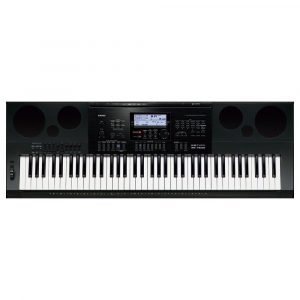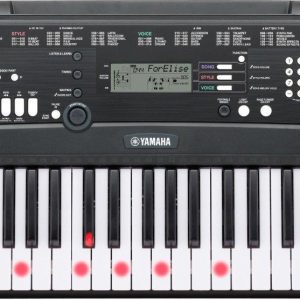Kawai ES 100
$425.99
Get the perfect digital piano for your music production needs with the Kawai ES 100 – the perfect combination of authentic sound, modern technology, and an affordable price tag.
Compare
Description
Kawai ES 100 Keyboard: The Best Compact Digital Piano for Professionals and Beginners
Kawai, a renowned brand in the world of professional digital pianos, has always been at the forefront of creating exceptionally high-quality instruments. The Kawai ES 100 Keyboard is no exception to this. It is known for its stunning sound quality, smooth key action, and affordability.
Design and Features:
The Kawai ES 100 keyboard features an attractive and sleek design, which makes it an excellent addition to any home, studio or stage setting. The compact 88-key digital piano comes with a weighted hammer action, which imitates the touch of an acoustic piano. It also allows players to experience real weighted action and responsiveness, which is ideal for both beginners and professionals.
Sound Quality:
The Kawai ES 100 Keyboard delivers an impressive sound quality that is rich and expressive. It features the Harmonic Imaging technology, which creates a beautifully natural and realistic piano sound. This technology is designed to capture every detail of the piano sound, including the harmonics, string resonance, and other nuances.
Voices and Effects:
In addition to the beautiful piano sounds, the Kawai ES 100 Keyboard also includes a range of other voices and effects. It features 19 different voices, including electric pianos, organs, strings, and bass, among others. These voices can be used individually, or in combination to create unique sounds. The keyboard also includes reverb and chorus effects, which can be used to enhance the overall sound quality.
Connectivity:
The Kawai ES 100 Keyboard comes with several connectivity options, which allow users to connect the keyboard to other devices. It includes a MIDI port, which can be used to connect to a computer or other MIDI-compatible devices. It also includes two headphone jacks, which are handy for private practice or for playing with a partner.
Other Features:
The Kawai ES 100 Keyboard includes several other features that make it an excellent choice for both beginners and professionals. It is lightweight and portable, making it easy to transport to gigs or lessons. It also includes a metronome and lesson function, which can be useful for practicing and learning.
Conclusion:
Overall, the Kawai ES 100 Keyboard is a premium quality digital piano that offers exceptional sound quality, excellent key action, and an extensive range of features. It is an excellent choice for both beginners and professionals looking for a compact digital piano that can deliver outstanding performance. With its affordability and quality, this keyboard is an excellent investment that will last for years to come.
Kawai ES 100 properties
| Product name |
ES 100 |
| Brand |
Kawai |
| Type |
Keyboard Instruments |
| Keyboard Instrument |
Keyboard |
| Keys |
Yes |
| Number of Keys |
88 pcs |
| Key Functions |
Dual Layer, Split |
| Pre-Programmed Sounds |
Yes |
| Pre-Programmed Effects |
Yes |
| Speakers |
Yes |
| Connections |
MIDI, MIDI In |
| Colour |
Black |
| Power Supply |
Electrical Cable to Wall Socket |
Frequently Asked Questions:
How does the Harmonic Imaging sound technology featured in the Kawai ES 100 differ from traditional digital piano sampling methods?
The Harmonic Imaging sound technology used in the Kawai ES 100 is different from traditional digital piano sampling methods because it goes beyond simple sampling to capture the unique harmonic characteristics of an acoustic piano. This technology uses special microphones and advanced signal processing techniques to record the complex, rich resonance that occurs when notes are played on a concert grand piano. The resulting samples are then assigned to individual keys across the entire keyboard, ensuring that each note produces a sympathetic response and accurately reflects the behavior of an acoustic instrument. In contrast, traditional digital piano sampling methods typically only capture the sound of single notes being played, without taking into account the complex interactions between different notes and harmonics within a chord or melody. The result can be less nuanced and expressive than the rich, multidimensional sound produced by an acoustic instrument.
How does the Soundboard Speaker System technology in the Kawai ES 100 digital piano differentiate it from other entry-level models in its class?
The Soundboard Speaker System technology found in the Kawai ES 100 digital piano sets it apart from other entry-level models in its class. This innovative technology uses the same material and resonant properties as the soundboards of Kawai's acoustic pianos to produce a richer, more lifelike sound that is both vivid and detailed. Additionally, this system allows for a more spacious and realistic sound projection, making the listening experience more immersive for both the player and audience. Overall, this technology enhances the ES 100's tone quality, setting it apart from other digital pianos in its price range.
How does the Harmonic Imaging sound technology in the Kawai ES 100 keyboard enhance the realism and expressiveness of its sounds?
The Harmonic Imaging sound technology in the Kawai ES 100 keyboard significantly enhances the realism and expressiveness of its sounds by utilizing advanced sampling techniques to capture the natural behavior of acoustic instruments. This technology allows for a smooth and gradual change in timbre as keys are pressed harder, simulating the nuanced tonal character that instrumentalists aspire to achieve through technique and touch. Additionally, it reproduces the characteristic reverberation characteristics unique to each acoustic space, providing a rich and immersive listening experience that further adds to the overall authenticity of the sound. Overall, Harmonic Imaging ensures that the ES 100's sounds are incredibly detailed, dynamic, and lifelike, making it an excellent choice for musicians looking to elevate their performances.
What specific features set the Kawai ES 100 apart from other digital pianos in terms of touch sensitivity and sound quality?
The Kawai ES 100 digital piano stands out from its competitors due to its exceptional touch sensitivity and superior sound quality. The keyboard action of the ES 100 is designed to closely replicate the feel of a traditional acoustic grand piano, with graded hammer action that provides different levels of touch sensitivity depending on the location on the keys. This means that pianists can play with greater nuance and expression, allowing them to convey subtleties in their performances that would be difficult or impossible to achieve on other digital pianos. In terms of sound quality, the ES 100 features Kawai's proprietary Harmonic Imaging technology, which delivers a rich and detailed piano tone that is remarkably similar to that of a high-end acoustic grand piano. This technology analyzes the unique sonic characteristics of each individual note on the keyboard and replicates them faithfully in the digital sound. The result is a level of realism and expressiveness that is unmatched by other digital pianos, making the ES 100 an excellent choice for serious pianists who demand the highest possible standard of sound quality. Overall, these features set the Kawai ES 100 apart from other digital pianos and make it a top choice for anyone looking for a high-quality instrument that combines exceptional touch sensitivity, rich sound quality, and modern convenience.
What are the specific technical requirements for maintaining and repairing the Kawai ES-100's sampled piano sound engine to ensure optimal performance over time?
1. Memory**: The sampled piano sounds are stored in the piano's memory. Over time, these files can become corrupted or worn out due to repeated playback and storage. To prevent this, it's essential to regularly update the piano's firmware and software to ensure compatibility with the latest sound libraries. Sample Rate and Bit Depth**: The sample rate determines how many times per second a sound is sampled, while bit depth indicates the number of bits used to represent each sample. For optimal performance, you'll want to maintain a high sample rate (44. Hz or higher) and use 16-bit or 24-bit resolution for maximum dynamic range. DAC (Digital-to-Analog Converter)**: The DAC converts digital samples into analog signals that drive the piano's speakers. To ensure optimal performance, the DAC should be calibrated regularly to maintain its linearity and accuracy. You may need to replace the DAC if it becomes damaged or worn out over time. Power Supply**: A stable power supply is crucial for maintaining optimal performance in the sampled piano sound engine. Consider using a high-quality power conditioner or surge protector to safeguard against power fluctuations and electrical noise. Speaker System**: The speaker system should be designed to accurately reproduce the sampled sounds without distortion or coloration. Regular maintenance of the speakers, including cleaning and replacement of worn-out components, is essential for optimal performance. Noise Reduction**: Environmental noise can degrade the sound quality over time. To minimize this effect, consider installing a noise reduction system or using acoustic treatment in the room where the piano is located. Maintenance Software**: Kawai typically provides maintenance software that allows you to update the piano's firmware and software, as well as perform diagnostic tests on the sampled sound engine. Regularly running this software will help identify and fix any issues before they cause problems. Calibration**: Periodically calibrate the piano to ensure its performance remains optimal. This may involve adjusting the tone settings, reinitializing the DAC, or recalibrating the speaker system. Component Replacement**: Over time, components within the sampled sound engine can wear out or become damaged. Regularly inspect and replace any worn-out components, such as capacitors or resistors, to maintain optimal performance. Environmental Factors**: Environmental factors like temperature, humidity, and dust can affect the piano's performance over time. Ensure the piano is stored in a stable environment with controlled temperatures (between 65°F and 75°F) and humidity levels (between 40% and 60%). By following these technical requirements, you'll be able to maintain and repair your Kawai ES-100's sampled piano sound engine and ensure optimal performance over time.
Frequenty asked questions about Kawai ES 100
How to connect Kawai ES 100 to computer?
Kawai ES 100 keyboard is a standalone instrument that has its own sound engine. However you can connect it to a PC/Mac computer. It will significantly extend the functions and usability of the instrument. You can use USB-MIDI interface to control co called DAW Software like Ableton Live, Fl Studio, Logic Pro or Cubase to record MIDI notes and command or pure digital audio.
Click here for more informations about Keyboard to PC connectivity
Before you buy Kawai ES 100






Kennedy Rivas –
I recently had the pleasure of using the Kawai ES 100 digital piano during my stay at Premier Inn Luton Town Centre. As a music enthusiast, I understand the importance of brand when it comes to keyboard instruments. Kawai is a renowned brand known for its high-quality instruments, and I was drawn to the ES 100 for this reason.
What sets the Kawai ES 100 apart from other keyboards is its exceptional touch and feel. The Responsive Hammer Compact action of the keyboard perfectly emulates the touch of a traditional acoustic piano, providing a truly immersive playing experience. This is especially crucial for me as a pianist because it allows me to express my emotions through my music.
Additionally, the ES 100 offers a wide range of sounds, including grand pianos, electric pianos, organs, and strings. This versatility allows me to explore various genres and styles during my performances. The Dual and Split modes further enhance my creativity by allowing me to layer sounds or split the keyboard into two separate instruments.
Overall, the Kawai ES 100 lives up to its reputation as a top-notch keyboard. The combination of the Kawai brand, the authentic touch, and the extensive sound options make it a standout choice for any pianist, whether professional or amateur.